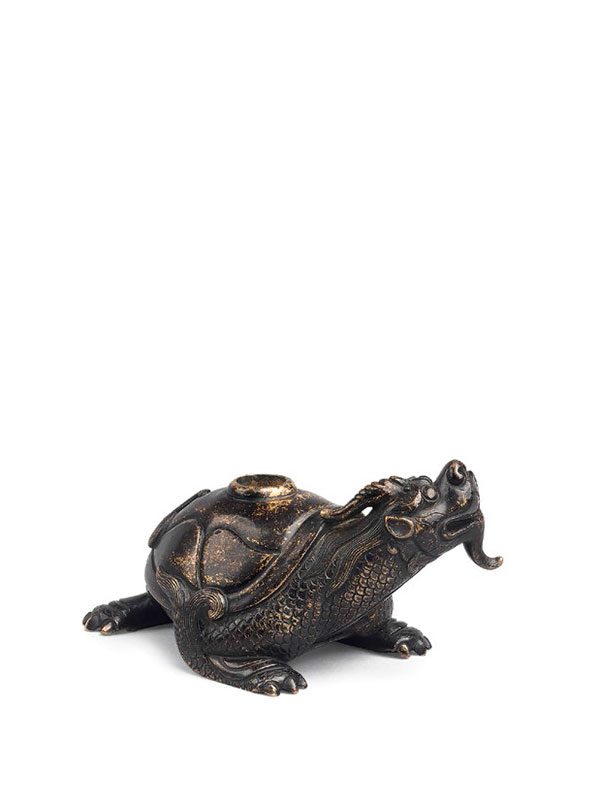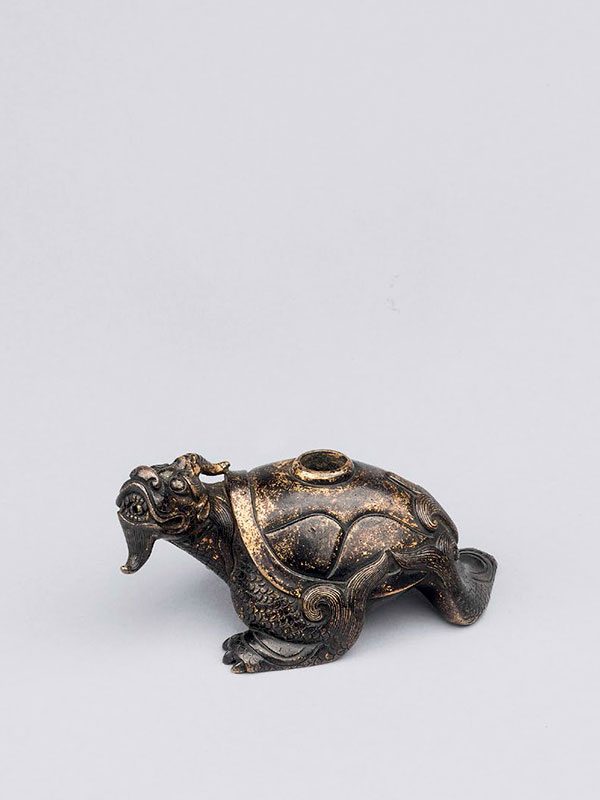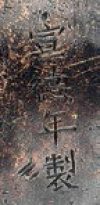Gilded bronze water dropper in the form of a mythical animal
A gilded bronze water dropper in the form of a mythical animal. This creature has a singlehorned, dragon-like head and the body of a tortoise with three feet. Its bulging eyes, wavy mane, scaly body and three-clawed feet are finely cast and carved. An aperture is positioned in the middle of the back for allowing water to be poured into the hollow body, whilst the mouth has a small opening. The base is engraved with the four-character mark of Xuande (Xuande Nian Zhi). It has acquired a deep patina whilst some of the original gilding is visible.
This bronze water dropper is the type of vessel for adding water to rubbed ink, using an ink-stone. The flow of water could be controlled by placing a finger or thumb over the aperture in the back, and the tiny hole in the mouth acted as the spout. Apart from its practical function, it is also a finely cast miniature sculpture for the scholar’s desk. Although the piece is engraved with the four-character mark of the emperor Xuande, who reigned from 1425 to 1435, the piece is unlikely to date from that period, but the compactness and the delicate craftsmanship certainly suggest a Ming dynasty date, albeit of a somewhat later period. A three-footed tortoise is considered to be auspicious in Chinese culture, which was recorded in Shan Hai Jing (Classic of Mountains and Seas), a classic Chinese text and a compilation of mythic geography. A Ming dynasty jade water vessel in the form of a tuolong, a mythical beast that combines the features of a dragon and a tortoise, was exhibited in the Fung Ping Shan Museum at the University of Hong Kong in 1986.1 A gold-and-silver inlaid bronze water dropper in the form of a tortoise with a snake on its back (xuanwu in Chinese), similar in size and dated to the late 16th – 17th century, is in the Robert H. Clague collection at the Phoenix Art Museum.[2] A comparable bronze water dropper in the form of a flying qinlin, similar in size and dated to the 15th – 16th century, is illustrated in Chinese and Japanese Bronzes, A.D. 1100-1900.[3] A Yixing pottery water dropper of a three-legged tortoise, dated to the early 17th century, was included in the exhibition Yixing Pottery at the Hong Kong Museum of Art in 1981.[4]
Provenance: private collection, Hong Kong
- Tsang, G. and Moss, H. Arts from the Scholar’s Studio, Oriental Ceramic Society of Hong Kong, 1986, no. 231, p. 158
- Mowry, R. D. China’s Renaissance in Bronze, the Robert H. Clague Collection of Later Chinese Bronzes, Phoenix Art Museum, 1993, no. 44, p. 198
- Goedhuis, M., Chinese and Japanese Bronzes A.D, 1100-1900, Colnaghi Oriental, London, 1989, no. 33
- Bartholomew, T. T. Yixing Pottery, the Urban Council and the Hong Kong Museum of Art, 1981, no. 24, p. 84
銅鎏金神獸硯滴
明 十六 – 十七世紀
長:10.5 公分 高:5 公分
銅鑄鎏金三足神獸,獸呈伏臥狀,頭微仰向左微撇,獸首描繪細膩,圓頭闊嘴,翹鼻豎耳,獨角
向後伸張,獸身鱗片密佈,背上伏一龜甲,甲上正中開一圓孔為入水處,獸口中央一小孔為出水
處。獸腹淺刻「宣德年製」四字楷書托款。此神獸形似三足龜,前二後一足,《山海經》載:「
其陽狂水出焉,西南流注于伊水,其中多三足龜,食者無大疾,可以已腫。」後又稱鼉龍,為龍
與龜之合體。香港大學曾於1986年展出一件明代玉質鼉龍硯滴,可茲比較。
來源: 香港私人收藏



